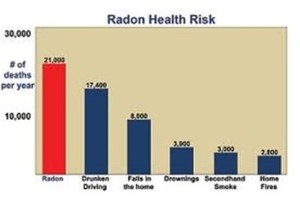14% of lung cancer cases are caused by low- and medium-level exposure to radon in homes. This makes it the second leading cause of lung cancer.
You can’t see radon or smell it or taste it.

It is estimated that 15% of homes would show high radon if tested. It’s best to test your home when the humidity is low and the house is closed, which is in the cooler months.
Radon is a radioactive gas. It is found in nearly all soils. It typically moves up through the ground to the air above and into your home through cracks and other holes in the foundation.
Your home traps radon inside, where it can build up. Any home may have a radon problem. This means new and old homes, well-sealed and drafty homes, and homes with or without basements.
The only way to know about radon in your home is to test.
You can’t see radon, but it’s not hard to find out if you have a radon problem in your home. All you need to do is test for radon by hiring a qualified tester to do the testing for you.
If you’ve tested the air in your home and found a radon problem, and your water comes from a well, have your water tested.
Since there is no known safe level of radon, there can always be some risk. But the risk can be reduced by lowering the radon level in your home.
There are several proven methods to reduce radon in your home, but the one primarily used is a vent pipe system and fan, which pulls radon from beneath the house and vents it to the outside.
Lowering high radon levels requires technical knowledge and special skills. You should use a contractor who is trained to fix radon problems. A qualified contractor can study the radon problem in your home and help you pick the right treatment method.
For additional information, read the Citizens Guide to Radon.


